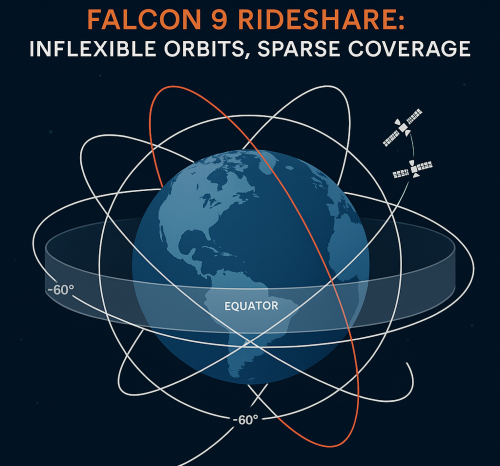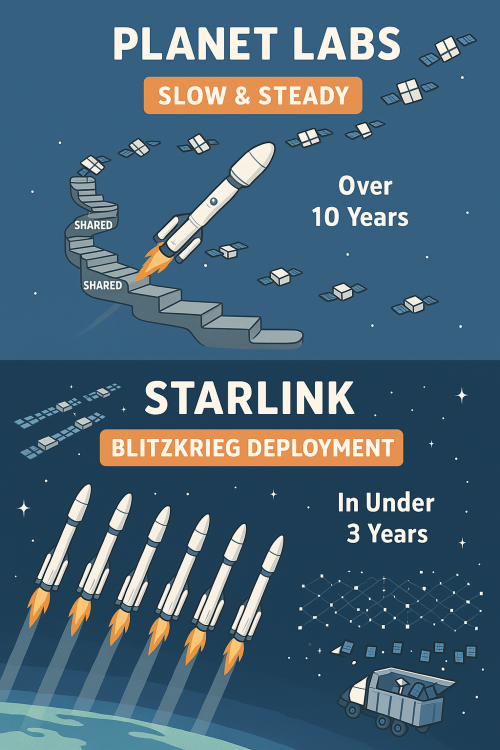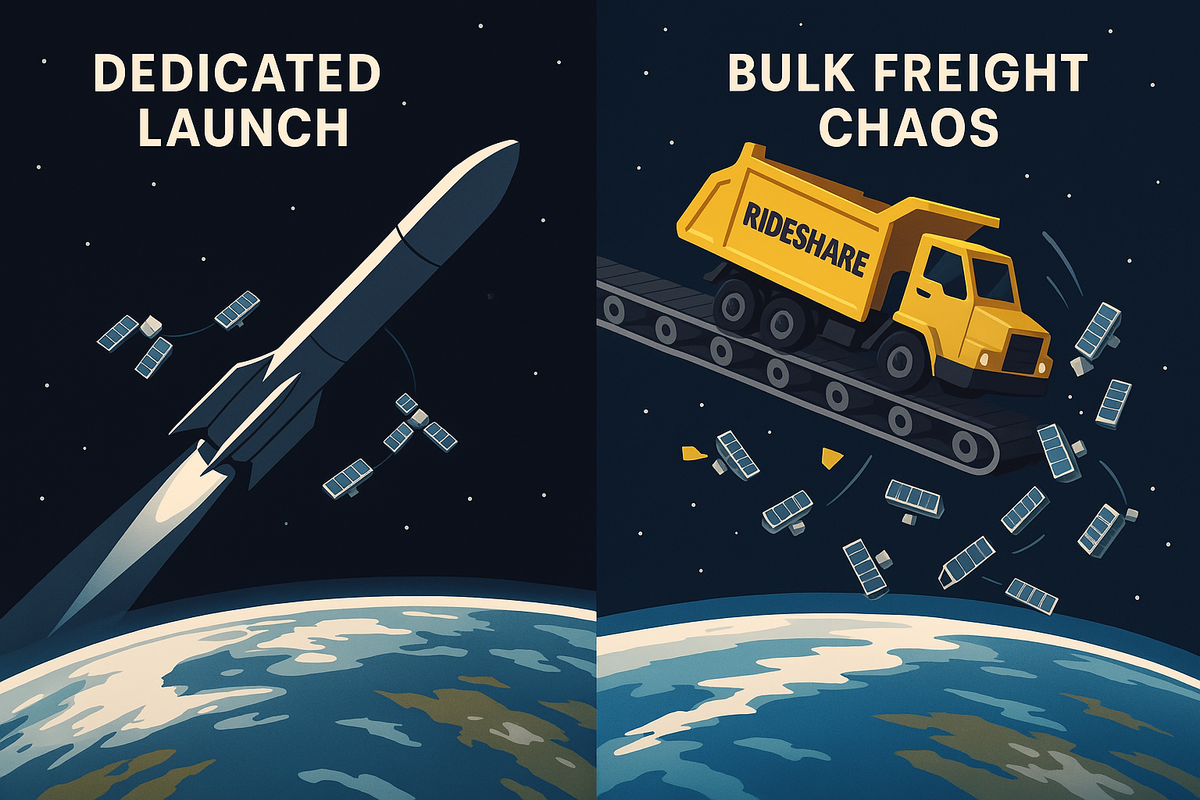In aerospace, just as in haute cuisine, the difference between spectacular success and soul-crushing failure often comes down to the smallest details. Anthony Bourdain could walk into a kitchen and immediately tell which chefs had their fundamentals dialed in versus those just going through the motions. The same discerning eye is needed when evaluating space ventures—especially the ones promising to reshape the world with sprawling constellations of small satellites.
In the first part of this primer, we explored how rocket physics and orbital mechanics form the foundation of the new space economy. We saw how adding more satellites to orbit can dramatically enhance coverage and revisit times—enabling services that a single satellite could never deliver. It all sounded promising.
Yet there’s a critical question: Can we truly scale constellations of small satellites using “cheap” rideshare launches? The physics (and cold, hard economics) clearly indicate that the answer is no. In this follow-up, we’re going to examine why “just hitch a ride on a big rocket” is basically the culinary equivalent of throwing all your ingredients in one pot and hoping for the best.
The 30–100 kg Smallsat Sweet Spot
Microsatellites in the 30–100 kg class are the workhorses of modern constellations - and they are the future of one hundred billion dollar space enterprises. They’re large enough for advanced payloads—like high-resolution cameras or 5G m—yet small enough to build and launch in bulk.
- 5G Non-Terrestrial Networks (NTN): Companies like OneWeb (with ≈150 kg satellites) and Lynk (≈50 kg) are pioneering direct-to-phone connectivity from space. A true 5G NTN constellation demands hundreds of satellites for global coverage.
- Intelligence, Surveillance, Reconnaissance (ISR): Defense and Earth-observation organizations are launching swarms of smallsats to monitor ground activity in near-real-time. A single 50 kg imaging satellite can revisit a target once daily, but a fleet can do so every hour or less.
- Earth Observation at Scale: Providers such as Planet Labs have deployed hundreds of small satellites to image the entire planet daily—collecting more than 25 TB of data. Yet scaling to this level took Planet nearly a decade. Why? They relied primarily on “budget-friendly” Falcon 9 rideshares and ended up with a revisit frequency of around six hours.
The potential is obvious; these applications promise global coverage, speedy iteration, and (relatively) lower cost compared to big multi-ton behemoths. But there’s a dangerous misconception lurking in many pitch decks: assuming that because one smallsat is “cheap” to build and launch, you can just replicate that process hundreds of times without hitting massive orbital mechanics constraints.
Let’s peel back the onion on why “just toss them on any available rocket” isn’t a real growth strategy.
The Rideshare Constellation Conundrum

Rideshare launches (think SpaceX’s Falcon 9 Transporter missions) let numerous small satellites share one rocket, chopping down cost per kilogram. For single demos or a first handful of satellites, rideshares are a gift from the heavens. Once you’re aiming to stand up a robust constellation, though, the constraints pile on fast:
- All Satellites, One Orbit (Orbital Plane Access)
In rideshare, your satellites go where the primary customer is going—like it or not. If your goal is multiple orbital planes (to achieve global coverage), you’re out of luck. Placing satellites in different planes often demands separate launches to unique inclinations. Relying on rideshare for that basically means hoping for a lottery win: the precise orbits you need at the times you need them rarely, if ever, appear on the manifest. - No Say on Schedule (Timing & Launch Cadence)
You can’t control when a rideshare rocket flies. If your plan calls for quarterly satellite additions or rapid replacement of failed units, the next available rideshare slot might be a year or two away. Sitting around waiting is not a path to outpacing well-funded competitors. - Injection Orbit = Starting Cluster (Phasing & Dispersal Challenges)
After deployment, all satellites are clumped in the same initial region. Spreading them evenly across an orbital plane can take months—sometimes years—of careful thruster maneuvers, which small satellites can’t afford to do haphazardly. - Limited Orbital Choices (Inclination & Altitude)
Most rideshares are to popular orbits (e.g., sun-synchronous around 500 km altitude, or ~45° inclinations). If your constellation demands something else, you’ll have to carry extra onboard propulsion—or, more likely, accept suboptimal orbits that underdeliver on coverage. - No Coordination for Constellation Deployment
Building a large constellation is like choreographing a ballet. You want satellites inserted into specific orbital slots in a synchronized way. With rideshares, you don’t control the stage, the curtain times, or even the music. Good luck getting your “dance troupe” in the right places.
Key takeaway: Rideshares function like a bulk freight service, whereas a truly scalable constellation demands something closer to an on-demand FedEx approach—precise orbital delivery on your schedule.
Case Study: Planet Labs vs. Starlink – Two Paths to Orbit

Nothing illustrates this better than comparing how Planet Labs and SpaceX each built out their constellations:
Planet Labs: The Rideshare Route (Slow & Steady)
- The Decade-Long Deployment
Starting in 2013, Planet piggybacked on essentially any available rocket as a secondary payload, ending up with hundreds of small satellites over ~10 years. - Clustered in Sun-Synchronous Orbits
Their satellites mostly ended up in polar, sun-synchronous orbit (SSO), capturing daily images at the same local solar time. While it provides daily global coverage, each location is effectively imaged once (maybe a few times) per day. - Revisit Times Measured in Hours
By sprinkling satellites across multiple SSO planes (when possible) and eventually using mid-inclination rideshares, they got revisit times down to around four to six hours in select regions. That’s impressive for rideshare, but it’s still not real-time coverage. - Losses and Delays
Planet had to endure other missions’ schedule slips and even launch failures. Since they didn’t control the rocket, they couldn’t call the shots.
SpaceX Starlink: The Dedicated Blitz (Fast & Global)
- Rapid Fire Launch Campaign
Starlink used dedicated Falcon 9s to launch batches of ~60 satellites at a time, starting in May 2019. Within two years, they had over 1,500 satellites in orbit. - Multiple Orbital Planes from Day One
By purchasing the entire rocket, SpaceX systematically filled dozens of orbital planes, ensuring full coverage at mid-latitudes and polar regions within a few years. - Global, Real-Time Coverage in Under 3 Years
By mid-2021 (just 28 months after the first dedicated launch), Starlink was on track for continuous global coverage. Latency is ~20–40 ms, allowing near-seamless broadband for millions of users. - Tight Coordination & Phasing
With each mission custom-tailored to the orbit, the satellites quickly reached operational positions—no year-long drift needed.
The Bottom Line: Planet Labs used rideshares and took ~10 years to achieve daily coverage with revisit times in the multi-hour range. SpaceX used dedicated launches and got global internet in under three years. If a startup promises “Starlink-level performance” but has a “Planet-level” rideshare plan, there’s a serious mismatch between ambition and feasibility.
The “Cheap = Scalable” Myth (Investor Beware)
It’s easy to see why the rideshare myth is tempting, especially for newcomers to the space sector. Transporter missions advertise costs as low as $5,000 per kilogram. From the outside, that might sound like an obvious money-saver: “We can launch 50-kg satellites for just $250,000 each!”
But that’s a classic trap—akin to equating the cost of flour with the success of your dish. Here’s why:
- Cost Per Kilogram vs. Mission Requirements
The hidden costs of orbital constraints can vastly exceed the upfront savings. You might need bigger onboard propulsion systems or extra satellites to patch coverage gaps. Meanwhile, every month of delayed deployment burns cash with zero return. - Bulk Freight ≠ On-Demand Delivery
A cheap ride to the wrong orbit at the wrong time is not actually cheap. Launch is part of your service design; if your customers expect real-time coverage, you need precise orbital targeting and high-cadence flights. - Evidence of Delays
History is littered with smallsat constellations that found themselves stuck on the ground for months (or years) waiting for the next “available rideshare.” Meanwhile, they hemorrhaged cash, losing precious lead time to competitors with more flexible launch strategies. - Misreading SpaceX’s Pricing
$5k/kg to SSO is a no-frills, secondary-payload deal. If you’re trying to run a real business with real customers, “no-frills” might be the last thing you want. - Rideshare Dependency Risk
Manifest changes, primary payload cancellations, or launch site scheduling shifts can leave you stranded. The more you depend on a bigger mission’s leftovers, the higher your strategic vulnerability.
What It Really Takes: Enabling Scalable Constellations
If cheap rideshare isn’t the magic bullet, then what does true scalability look like for 30–100 kg satellites in markets like 5G NTN, ISR, and Earth observation?
- Frequent, Responsive Access to Orbit
Imagine monthly or weekly launches on standby. You don’t wait for someone else’s plan; you call up a rocket as needed. This is crucial for rapidly replacing failed spacecraft or surging coverage in hot spots. - Orbit-Selectable, Precise Insertion
Operators must be able to target whichever orbit suits their coverage strategy—30°, 45°, 97°, you name it. That typically means dedicated launches or extremely flexible mission profiles. Small launch vehicles excel here by tailoring flights for one or a handful of satellites. - Multi-Orbit Deployment
Some constellations need a mixed bag of inclinations—like Starlink (mid-latitude and polar). A suitable launch partner (or combination of partners) can deploy satellites across a wide range of orbits in quick succession. - High Launch Cadence Coordination
Coordinated campaigns minimize the time from initial deployment to full coverage. Launch 10 times in 10 weeks to 10 orbital planes? That’s how you build a robust constellation quickly—unthinkable with rideshare. - Minimized Latency from Decision to Orbit
If a new satellite is needed on short notice, how soon can it launch? In a truly mature ecosystem, we’d measure that in weeks (or even days). This requires streamlined integration, standard interfaces, and on-call launch capabilities.
Conclusion: No Free Ride to Scale

The miniaturization of satellite tech is unlocking extraordinary possibilities—from global broadband to near-real-time Earth imagery. But getting from a single demonstration satellite to an operational fleet is far more complex than buying the cheapest rocket seats in bulk. Orbital mechanics, like economics, abides by the mantra that there’s no free lunch.
Rideshare launches can be a cost-effective start, but they’re fundamentally mismatched for high-performance constellations needing custom orbits and flexible schedules. If it was that easy, we’d have a dozen Starlink clones by now. We don’t—because scaling big constellations demands frequent, precise, and responsive launch capabilities.
For investors, the moral is simple: The next wave of the space revolution depends on logistics catching up with imagination. Building a real business in orbit means ensuring your satellites can get exactly where they need to be, exactly when they need to be there. Think of it as the difference between showing up with pre-packaged ingredients on your own timetable versus rummaging the discount bin at midnight. As Anthony Bourdain might have said, “A good meal is all about preparation and timing.”
And that’s the beauty of this era: with the right launch strategy, we can deploy and refresh orbital assets almost as flexibly as spinning up new servers in the cloud. That’s the real game-changer—the “rocket science magic” that separates starry-eyed demos from constellations that define the future.
References & Further Reading
- NASA Small Spacecraft Systems Virtual Institute – Integration & Launch Guides
https://www.nasa.gov/smallsat-institute/sst-guides/ - Planet Labs – Press Releases & Investor Materials
https://www.planet.com/investors/ - SpaceX – Starlink Program Overview
https://www.spacex.com/starlink - Rocket Lab – Dedicated Launch Services
https://www.rocketlabusa.com/launch/dedicated/ - Firefly Aerospace – Alpha Launch Vehicle Info
https://fireflyaerospace.com/alpha/ - 3GPP on 5G Non-Terrestrial Networks (NTN)
https://www.3gpp.org/news-events/2167-5g-satellites - MediaTek – Direct-to-Device 5G NTN Demonstration with Bullitt Group
https://www.mediatek.com/blog/mediatek-enables-smartphones-to-connect-anywhere-with-direct-to-satellite-ntn


